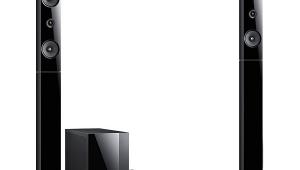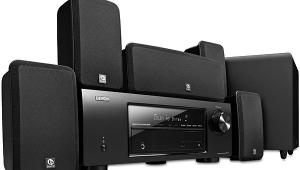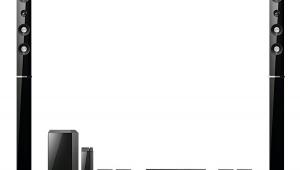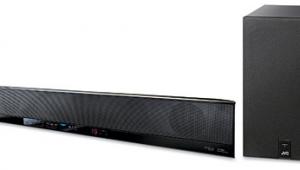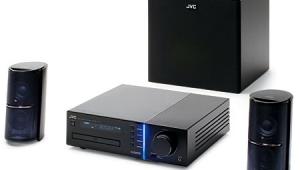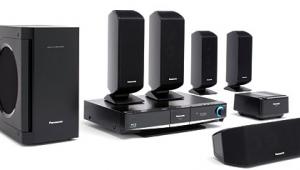Onkyo Envision LS-V500C HTIB
Instant home theater—speakers, a receiver, and a DVD player packaged tidily in a single box—is the hottest thing since the bare midriff. So why does it bug me so much? Maybe because so many sub-$1,000 systems bundle generic speakers that are about as flashy as the cardboard box they came in. Onkyo's response to this HTIB speaker crisis? With the Envision LS-V500C, you can take the speakers or leave 'em.

Take 'em or leave 'em? The compact LS-V500C retails for $900, but the system's DVD player/receiver unit is available separately as the DR-C500 for $600, in traditional black instead of silver. After having spent many hours listening to the LS-V500C, however, I'd recommend that you keep the system intact, speakers and all. But thanks for asking, Onkyo.
These days, people want home theater for dummies without having to read the book. The LS-V500C is a home theater that you can wire in less time than it takes to get an Antiques Roadshow appraisal on Grandpa's Edison Standard Model D phonograph. I connected the speakers to the DVD player/receiver unit and ran two interconnects from the audio inputs and a single S-video cable to my Sony Wega TV, then a single cable to the subwoofer. That's it. Onkyo includes color-coded, labeled speaker wire, so there's no risk of connecting the right-surround wire to the left-surround speaker terminal. Note, however, that the S-video cable isn't included. Assuming that your TV has an S-video input, it's an inexpensive upgrade from the composite video cable that comes packaged with the LS-V500C.
The satellites—the SKF-102F up front and the identical SKM-102S surround—are only 9 inches high, and the SKC-102C center-channel speaker is less than 13 inches wide. The 29-pound SKW-100 subwoofer, built like a bulked-up PC minitower, powers an 8-inch driver with a 150-watt amplifier. The LS-V500C also has an HTIB favorite: a five-disc DVD/CD carousel that also plays MP3-encoded CD-Rs/-RWs. It also has the routine surround formats, with built-in Dolby Digital, DTS, and Dolby Pro Logic II Movie/Music decoders.
The receiver achieves the industry-favored 100 watts per channel, but only when Onkyo measures total harmonic distortion into two channels driven at 1,000 hertz, an easy middle-register frequency. Here, Onkyo does the consumer no favor. (On their Website, the company lists all-channels-driven, full-frequency-range THD as 5 percent, or about five times higher than the average budget receiver.) In this case, trust your ears: Whatever the measurements, the DR-C500 is plenty powerful and plenty quiet for this system.

The budget LS-V500C seems an unlikely match for a digital TV, at least until DTV prices drop low enough that a $700 set becomes standard. When that time comes, the DR-C500's Y/Pb/Pr component video input and output will accept an HDTV set-top box. The DVD player's progressive-scan feature will then become relevant, too.
Make sure you don't lose that illuminated preprogrammed/learning remote, an excellent little control module that provides plenty of finger room between its buttons. You can't configure the speakers or access the DVD menu without it. With the system's Intelligent Power Management feature, the receiver even turns on and off automatically with your TV. So stay in your seat, if you wish. The LS-V500C isn't just a lifestyle system; it's a sedentary-lifestyle system.
Of course, $1,000 can get you more-high-tech technology. For instance, Yamaha's DVX-S100 has both Faroudja's DCDi video processing and DVD-Audio (see Adrienne Maxwell's review in the January 2003 issue). The LS-V500C lacks even six-channel inputs to add a separate SACD or DVD-Audio player. Next to Onkyo's more-substantial HT-S755DVC—a $1,000 6.1 system with surround sound exotica like Dolby EX and DTS ES, a separate DVD changer, and bigger, dual-woofer satellites—you might dismiss the poor LS-V500C as a home theater in basic training.
Don't be deceived, though. Line up the LS-V500C with some hotshot sub-$1,000 HTIBs, and it'll rate way up there in the most critical areas: realistic DVD soundtrack reproduction and full-bodied, nonfatiguing CD reproduction. The LS-V500C also looks silvery-smooth next to the customary Darth Vader–black components.
Although HTIB buyers often favor the smallest and lightest components, the DR-C500 can't help itself. A single chassis containing an A/V receiver and a five-disc DVD/CD carousel needs space, and this one measures about 17 inches wide, 17 deep, and almost 6 high. On the scale, it weighs precisely 30.2 pounds. Despite its bulk, it manages to look less cumbersome than the typical box-of-electronics receiver. The front slopes like a beginner's ski run laid on its side, with the flat runway spanning the on/off control, five plastic disc-selector buttons, and the cool blue display all positioned above the disc tray. A gentle slope leads to a raised panel that contains the remaining controls—not the usual cockpit instrument panel, but a not-at-all-intimidating assortment of basic controls like master volume, AM/FM tuning/presets, and play/pause.
A single button controls all of the surround modes. Press it, then view the selections on the display. A single button also controls the input source, whether it's TV or FM radio. This makes selecting a source easy for the novice who fears hitting the wrong button or can't find the appropriate one. Sometimes, it's almost too simple: The DVD/CD input is inaccessible at the receiver or via the remote. The machine acknowledges the disc automatically, flashes the DVD icon on the screen, and commences playing. Once you switch out of DVD mode, the disc stops.
On the DR-C500's backside, you'll find two digital inputs (coaxial and optical), an optical output, and two A/V inputs for a VCR or TV source, whether it's cable or satellite. Sorry, gamers and camera owners: There are no easy-access connections out front.
- Log in or register to post comments
